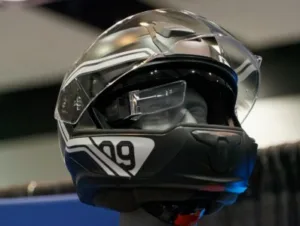AGC was showing its Glascene diffusion glass which is available in front or rear configurations and allows the use of projectors to create AR applications for retail and other shared spaces. The glass is currently on sale in Japan and the company was at the show to get feedback.
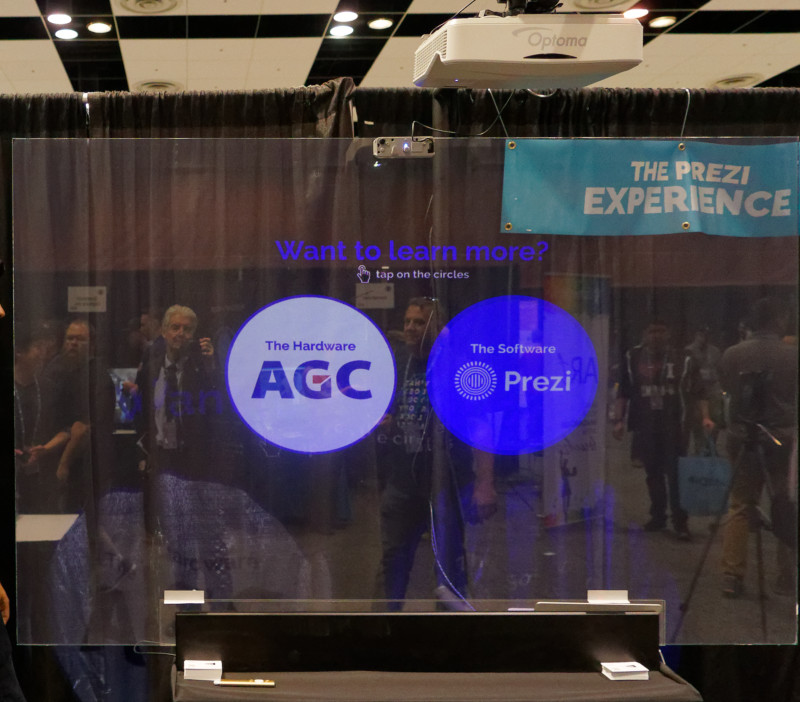 AGC was showing this front projection diffuser glass. Image:Meko
AGC was showing this front projection diffuser glass. Image:Meko
Daqri demonstrated its current hardware which is shipping and highlighted its developments in software, which we reported on from the event in Laval. (Laval Virtual 2018 Roundup)
Digilens did not have any new hardware as we had reported on the company at SID in the week before. It was showing applications including motorcycle helmet displays.
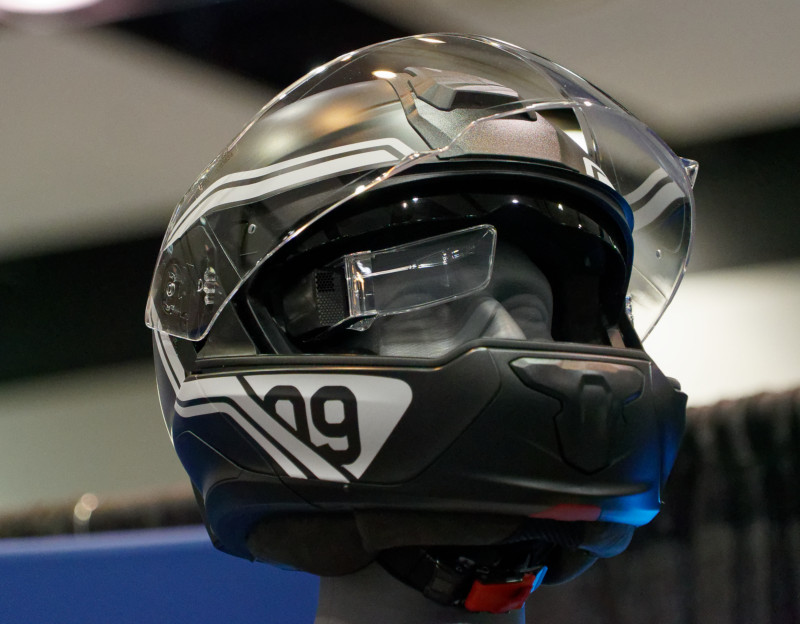 Digilens showed its waveguide in a motor cycle helmet. Image:Meko
Digilens showed its waveguide in a motor cycle helmet. Image:Meko
Dimenco which we reported on from SID was also showing its AS3D displays at AWE. It also had a ‘simulated reality’ system that it has been developing with UltraHaptics. The companies are planning to launch plug-ins for Unity and the Unreal engine and they hope to have finished products by the end of 2019.
Dreamworld AR was founded a couple of years ago from St Mateo and is developing headset displays that can be used with smartphones and tablets and are intended to open up potential applications to a wide audience as the cost of the headset is $399. The displays are at the top of the headset and are reflected back into the user’s eyes. The weight is said to be one third of the Microsoft Hololens.
The idea of mixed reality is important to the company, which believes that in many cases, situational awareness is critical for the application and for user safety. The company has a plug-in SDK for the Unity engine and can run its software on Android, MacOS or PCs.
The company has a plan to eventually develop a full system but the use of a separate processor that the buyer already owns is intended to make the barrier to entry lower for both users and developers. The displays are LCD-based and are 3″ diagonal with 2560 x 1440 resolution and producing 600 cd/m². The hardware is being manufactured in China.
The first batch of production units are expected in June or July

Epson was showing its Moverio glasses and was concentrating on how its new SDK (announced at the event) could be used to develop applications. There was no new hardware but the company was showing how the glasses could be used for flying drones – a significantly sized segment of the market.
We reported on Global Illumination in the past. The company has further developed its technology and now has a Unity plug-in to make content development simpler. The company has also added to the range of projectors that can be used although the main ones are Epson and Optoma and these can be fitted with the company’s patented lenses.
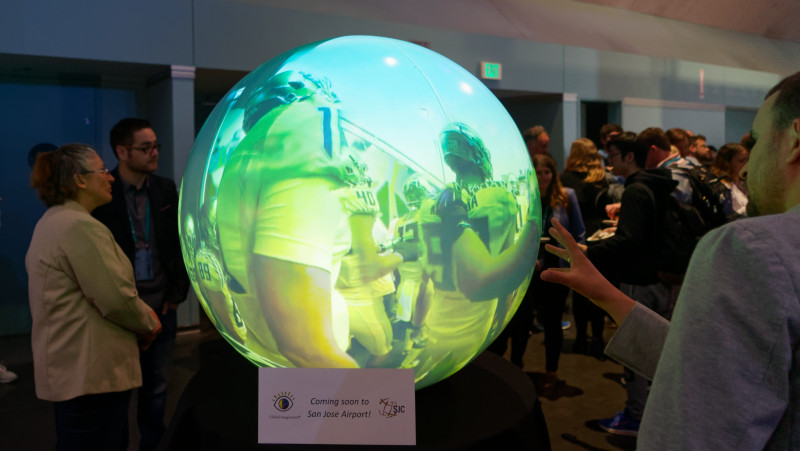 Global Illumination now has a plug-in for Unity to make content creation easier. Image:Meko
Global Illumination now has a plug-in for Unity to make content creation easier. Image:Meko
Identitoy believes that with the advent of smartphones and tablets, “Dad is the only one playing with construction toys”, so it has developed a baseplate that fits tablets and allows integration between the virtual world and building toys. Check out the video here. https://www.youtube.com/watch?v=uLn4zv62xXs
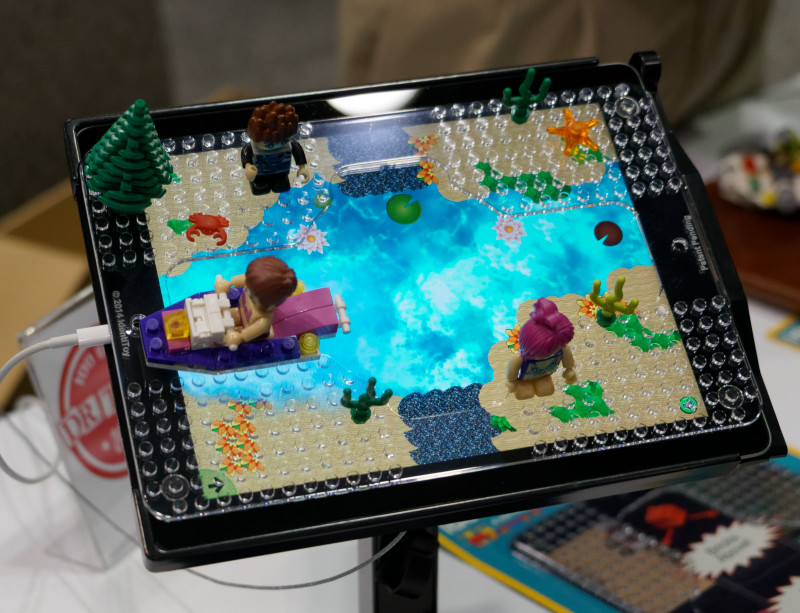 Identity combines VR with lego. Image:Meko
Identity combines VR with lego. Image:Meko
LC-Tec of Sweden is a developer of specialised liquid crystal-based devices and was showing how its liquid crystal technology could be used for light control and blocking in AR and mixed reality applications. The company can make devices on plastic, but can also use glass and switching can be from 50% to 5% or from 75% to 25% transparency. TN or Guest/host technology can be used according to the particular application requrirements with TN mainly used for optical switching and Guest Host used for see-through applications.
 LC-Tec has a range of LC solutions for AR & MR applications. Image:Meko
LC-Tec has a range of LC solutions for AR & MR applications. Image:Meko
LookingGlass Factory plans to launch its ‘volumetric/lightfield (well, not really!)’ display in July on Kickstarter. By the time we got to this booth, we were in rush mode, so didn’t get much more, but if you are interested in AS3D developments, check the company out! https://lookingglassfactory.com/
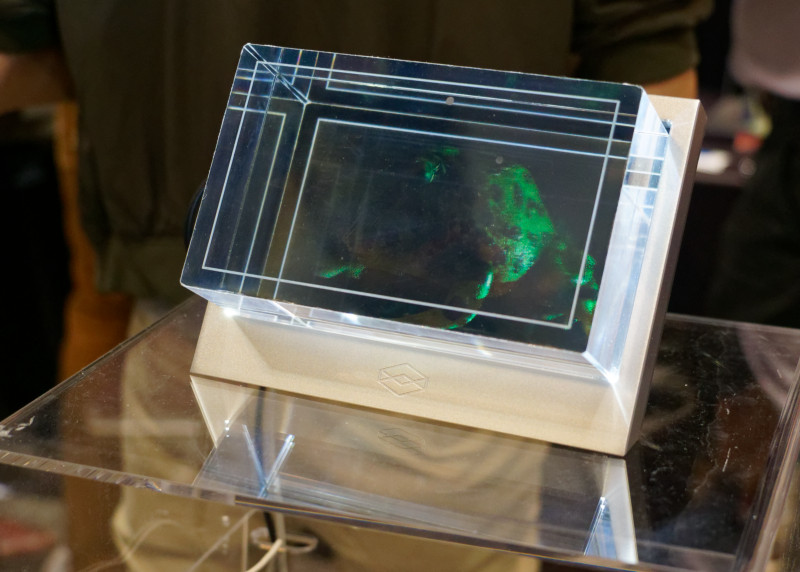 LookingGlass is planning to launch this AS3D or volumetric display in July. Image:Meko
LookingGlass is planning to launch this AS3D or volumetric display in July. Image:Meko
We didn’t get to Meta as there was a big line for demos when we went past and there wasn’t time to get back. However, others that tried the headset told us that while it was competent, the performance was somewhat ‘over hyped’ which would match the impression we got in 2016.
Microsoft had its current Hololens and was talking about applications. It was also showing a new service that it is offering via its cloud services which can take very complex 3D models and perform dramatic simplification to allow models to be used in AR and VR applications running on less sophisticated processors to allow reasonable frame rates. Staff showed us how a head model using 14 million triangles and taking 1.2GB could be optimised down to just 2K triangles using 2 MB of memory.
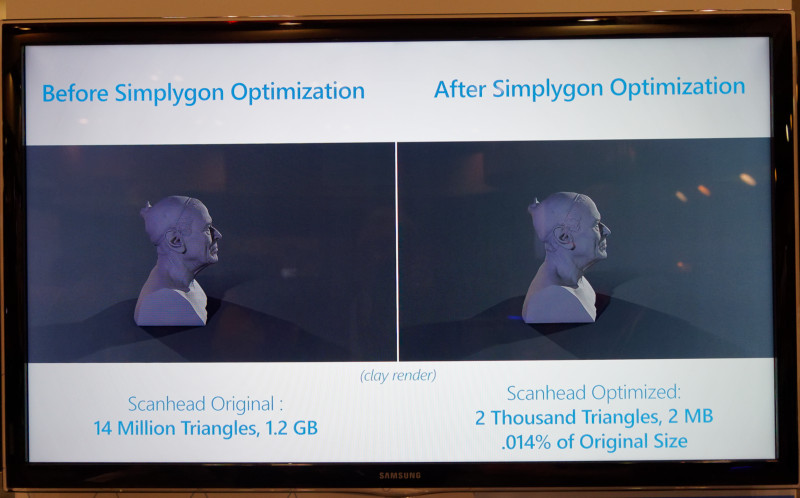 Microsoft is offering 3D model simplification via an API and in the cloud. Image:Meko
Microsoft is offering 3D model simplification via an API and in the cloud. Image:Meko
Mira has a smartphone-based AR headset that can be used along with the company’s own video and voice sharing “Remote Expert” services to allow collaborative working. The company believes that using existing smartphones (iPhones only at the moment) that are already approved and integrated into corporate IT makes adoption easier. The unit is low cost at $149 MSRP.
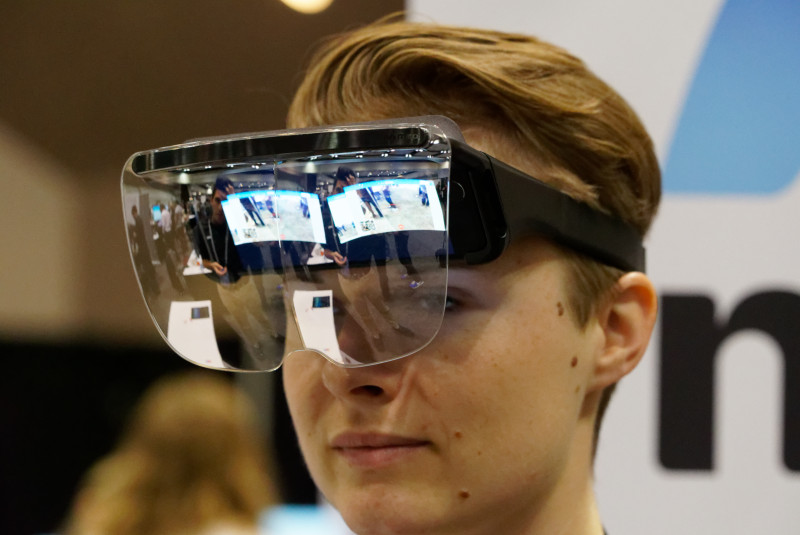 The Mira headset uses a smartphone and costs $149. Image:Meko
The Mira headset uses a smartphone and costs $149. Image:Meko
Olympus was showing its currently shipping AR display which uses special optics to block the light behind the imager making the image very solid, even in difficult lighting situations. The image area is very small so that the viewer can see all around the display and none of the real world is blocked. The resolution is 640 x 400 and there is a 2 megapixel camera. The system runs the Android OS and battery life is 30 – 60 minutes.
The EyeTrek Insight El-10 glasses were launched towards the end of last year and are shipping currently for around a $1,500 retail price. (Olympus EyeTrek Insight EI-10 Smart Glasses are for Business Use)
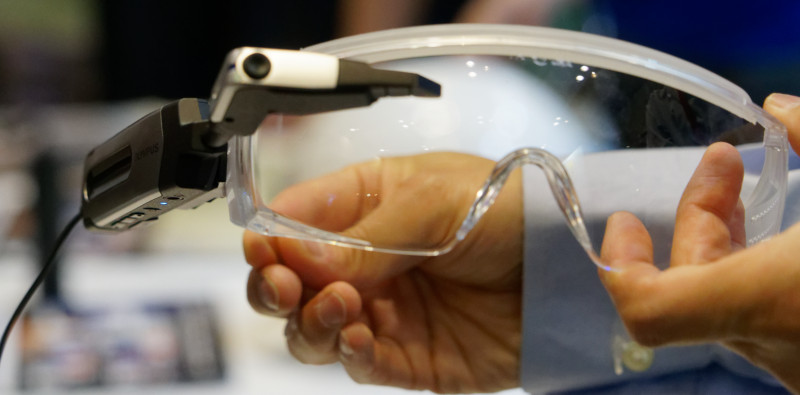 Olympus is shipping its AR headset which can be fitted to safety or prescription glasses. Image:Meko
Olympus is shipping its AR headset which can be fitted to safety or prescription glasses. Image:Meko
Osterhout Design Group (ODG) did not have any new hardware at the show as it is working to increase the supply of its R9 platform, which is now shipping in limited quantities in the face of high demand. The company highlighted to us that it has been working with Mastercard to develop retail and shopping applications that can exploit the possibilities of AR. It has also done a deal with KDDI of Japan (the second largest Japanese telco) to sell the ODG products in that country.
 ODG was highlighting its R9 platform and is working to meet the demand. Image:Meko
ODG was highlighting its R9 platform and is working to meet the demand. Image:Meko
Optinvent of Rennes, France, is another company that we have reported on several times this year. The company contrasted its very simple waveguide structure which makes it very suitable for mass production as it is made by injection moulding, making it very suitable for high volume consumer applications. That’s in sharp contrast to a technology such as the one from Lumus that takes six wafers and up to forty optical layers. The company is developing new versions of its waveguide that can provide a wider field of view.
(By the way, if you are in your office, you might want be careful looking up the name of the Optinvent engine – Ora-2 which seems to be very close to the name of ‘the world’s best oral sex vibrator’ !!!!)
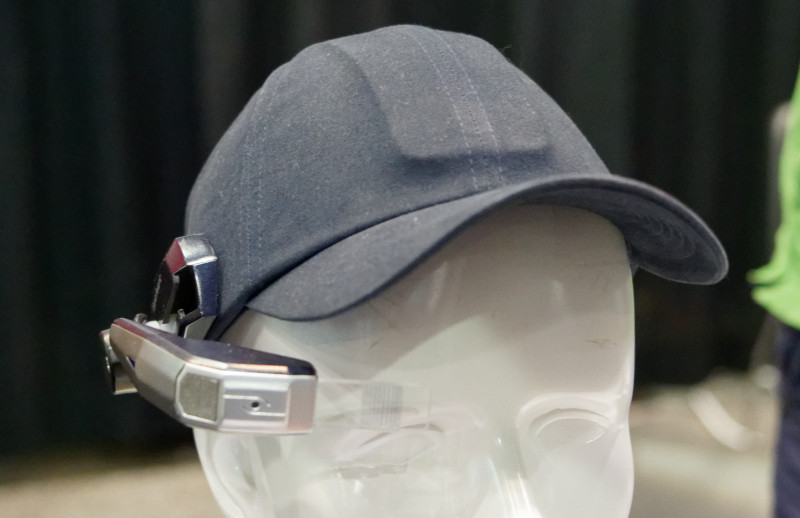 Optinvent is very proud of this AR hat that it has developed. Image:Meko
Optinvent is very proud of this AR hat that it has developed. Image:Meko
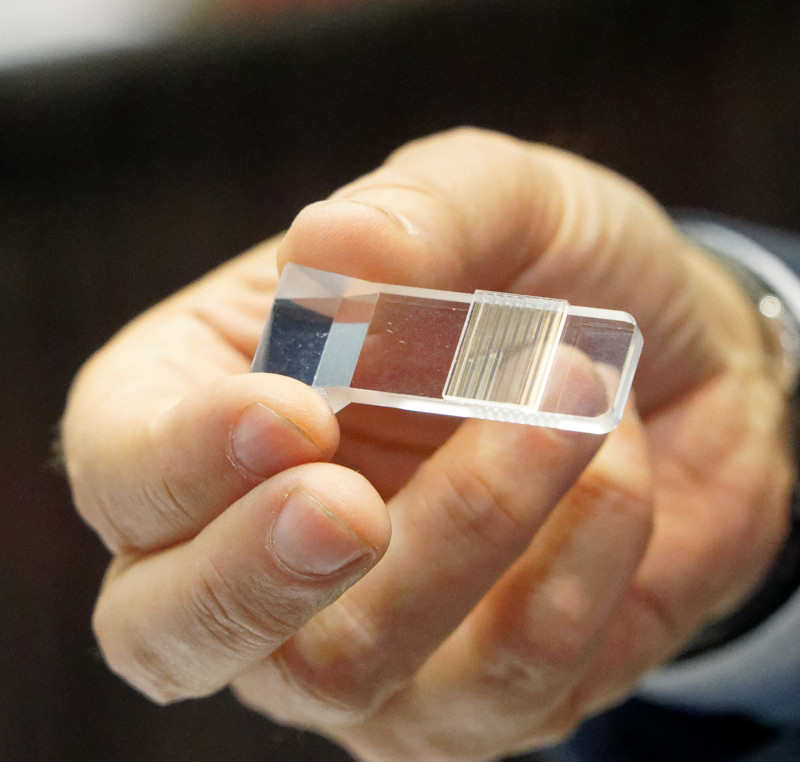 The Optinvent waveguide is incredibly simple and makes finished sets simple to assemble. Image:Meko
The Optinvent waveguide is incredibly simple and makes finished sets simple to assemble. Image:Meko
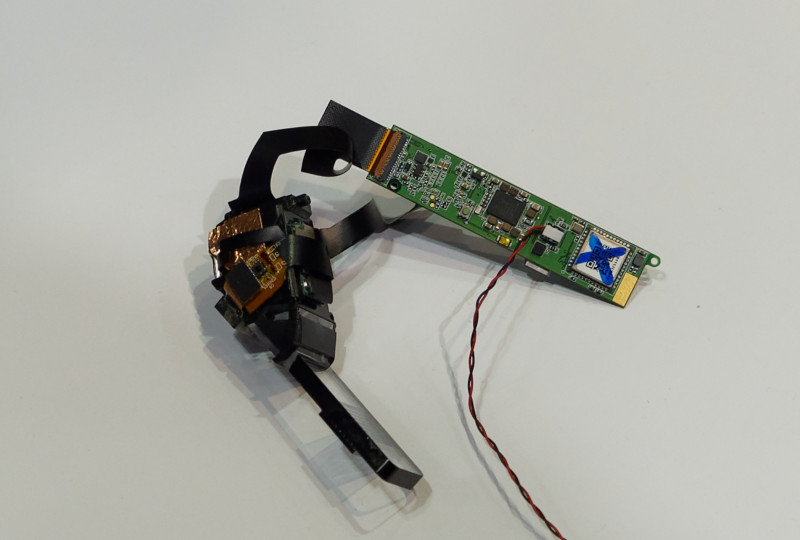 Optinvent has a module that it calls the Ora-2 (don’t look it up on Google). Image:Meko
Optinvent has a module that it calls the Ora-2 (don’t look it up on Google). Image:Meko
Raontech is from Korea, where it makes microdisplays, although it also has facilities in China. We reported on the company from SID (SID 2018 Show Floor Roundup)
It was showing the new 0.7″ 2560 x1440 display that we saw at SID and which is expected to start shipping in mid-2019 if all goes according to plan. We showed the prototype headset in our SID report and this time we managed to get a photo of the image through the lens.
At the moment, Raontech sees 0.5″ as the ‘sweet spot’ for AR displays.
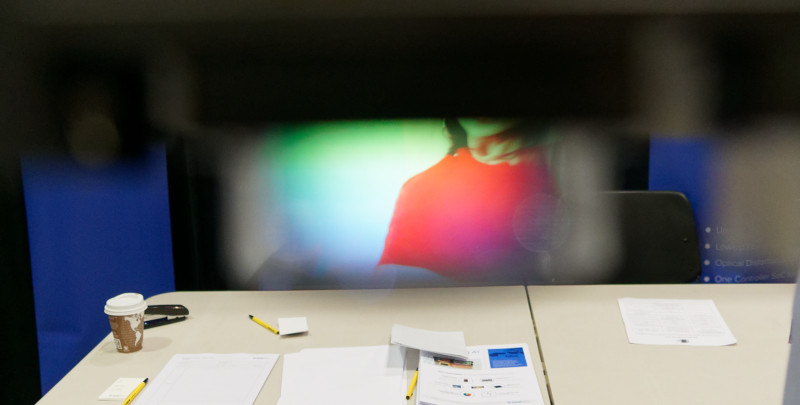 We took this picture of the Raontech imager through the lens of the mock up headset. Image:Meko
We took this picture of the Raontech imager through the lens of the mock up headset. Image:Meko
We saw RealWare, the Kopin spinout, when we were at the Wearables Show in London and the company had no new hardware at AWE. The company was showing its HMT-1Z1 which is now shipping worldwide and is being marketed by Honeywell. At the AWE press event, the company talked about its work in developing and certifying Apex compatible headsets for hazardous environments. (AWE Expo 2018 is a Rush)
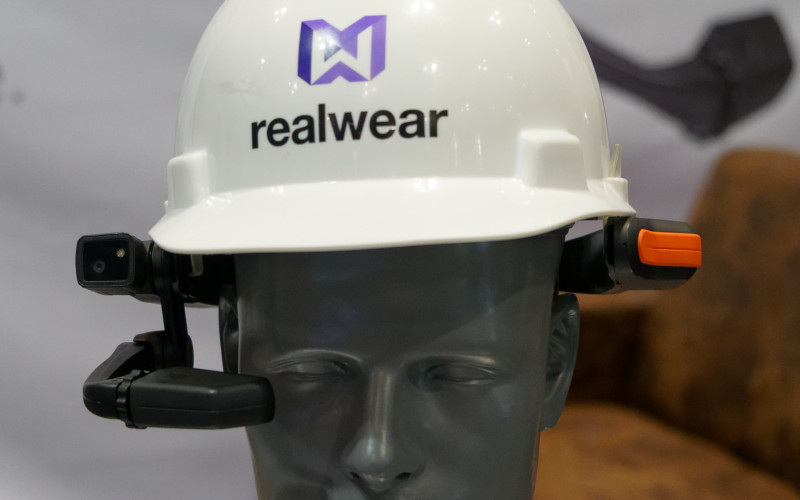 Realwear is marketing through Honeywell. Image:Meko
Realwear is marketing through Honeywell. Image:Meko
Toshiba was showing the system that it has developed based on the Vuzix headset and told us that it was a very conscious decision to choose to use a Windows-based architecture rather than Android because of potential issues with security in Android. Windows is completely understood in corporate environments and the system fully supports Windows 10.
The headsets can be fitted to safety glasses, hard hats and also to headbands and the display is fully adjustable up and down. There are programmable buttons which can be operated with gloves. The system has now started shipping.
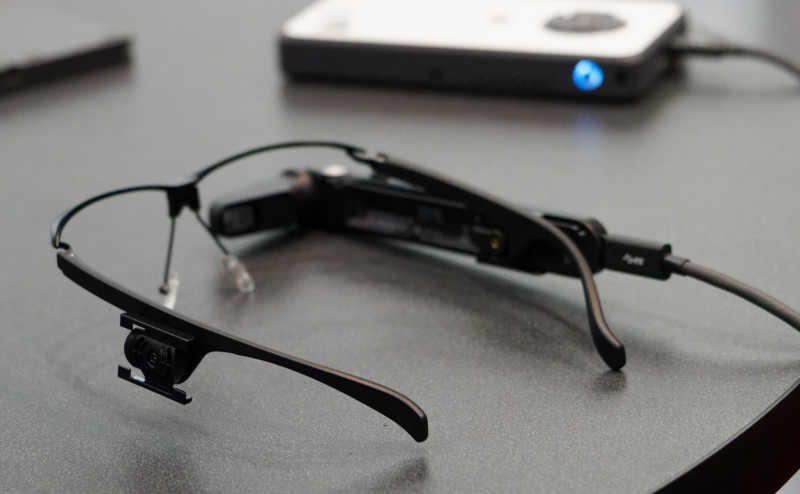 Toshiba is now shipping its Vuzix-originated glasses with Windows. Image:Meko
Toshiba is now shipping its Vuzix-originated glasses with Windows. Image:Meko
Trilite was showing its lasers and controller. The devices are very small and are low power, so can be used in direct to eye applications and the company told us that there is no speckle from the display. The company is planning to further downsize the lasers, although they are already very small.
The company told us that ‘any’ commercial MEMs scanning device can be used to spatially modulate the laser and resolutions from VGA up to FullHD can be supported with frame rates of up to 90Hz. Trilite told us that it is already working with Tier 1 OEMs.
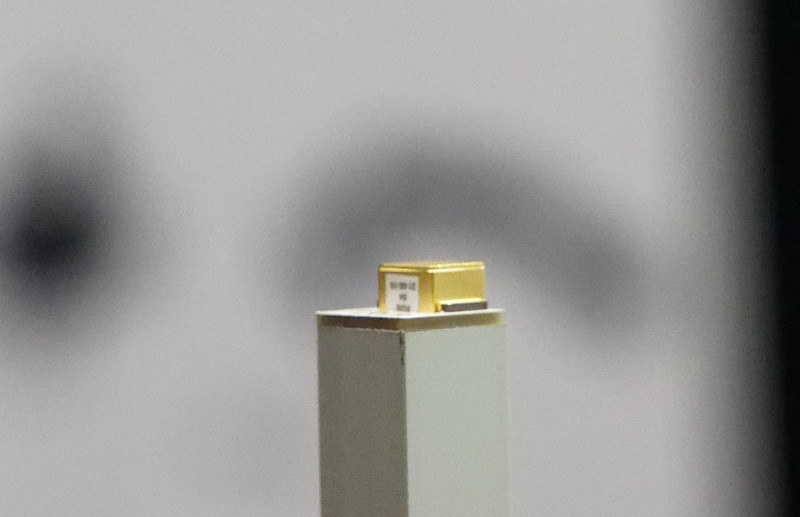 Trilite’s laser is very small… Image:Meko
Trilite’s laser is very small… Image:Meko
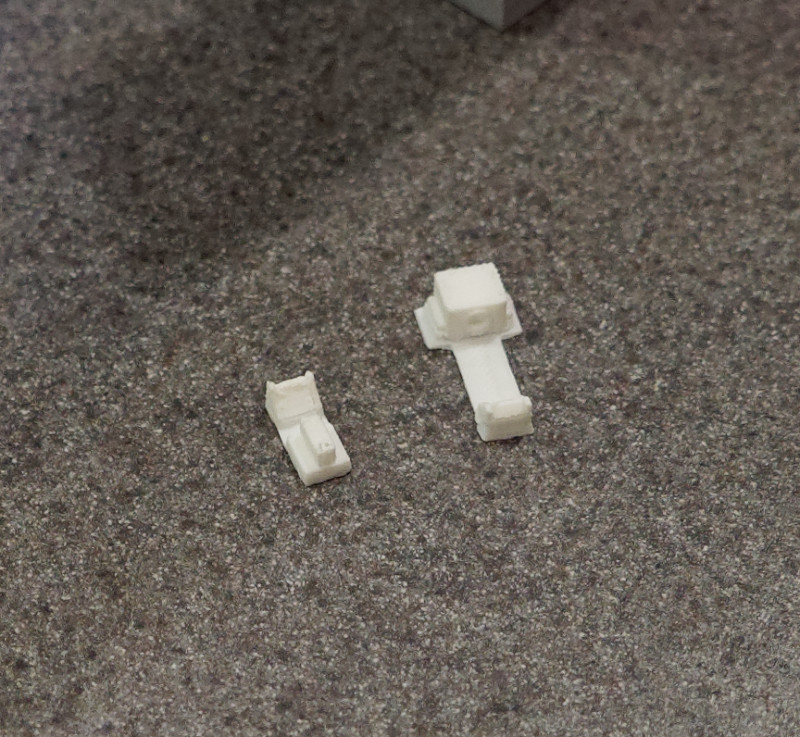 …. but the plan is to make even smaller devices. Image:Meko
…. but the plan is to make even smaller devices. Image:Meko
Unsurprisingly, as this was the third or fourth time we have met the company this year, Trivisio of Luxemburg did not have anything new in terms of hardware. (Trivisio Headsets Can be Customised)
Umbra is not a company we’ve reported on before and the company is based in Helsinki. It has around 30 people if you include the US office and the company has been around since 2006, when it came from high end gaming. The company has developed what it claims to be ‘best in class’ 3D optimisation and has done well enough that it has, effectively, saturated its market in gaming.
At CES, the company announced a new cloud-based launch of software for optimisation of models for professional applications such as architecture, engineering, construction, automotive, medical etc. No 3D expertise is needed, unlike other competitors. The company has a viewer that runs in iOS at the moment and the company was showing a demo of the viewer showing very complex models (13 million polygons) with high frame rates and very good quality. The architecture is based on optimisation in the cloud, with rendering locally. The company also showed a 10TB point cloud (based on a 700GB mesh) that had 2 billion polygons and was being viewed locally.
An advantage of the concept is that what is local is just a simplified version of the model and the full original dataset stays with the model supplier.
VRez was a new name to us and is aiming its headsets at personal cinema applications – the company’s headset uses dual “3K” LCDs that have 600 ppi and the company told us that it’s target price is $899. The headset is advertised as ‘super light’ but we didn’t think it was particularly light. The company is aiming to launch the product just in time for Christmas.
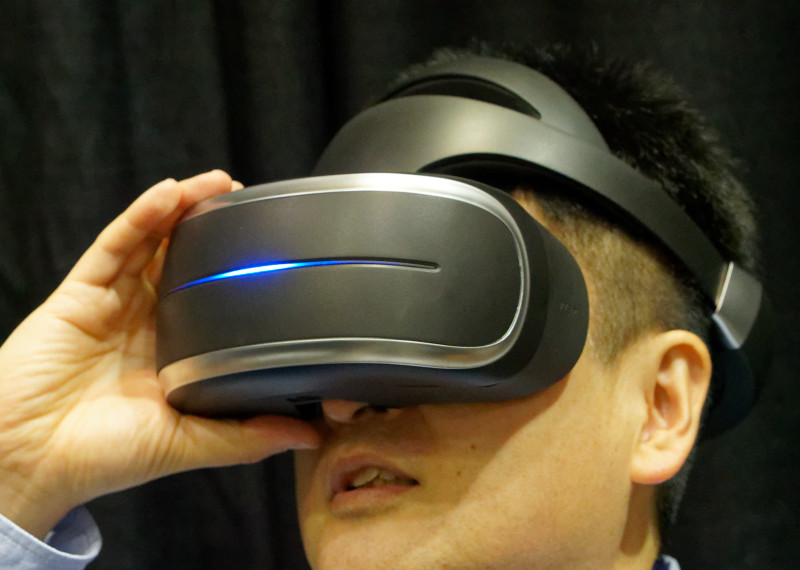 VRez is aiming at personal cinema applications
VRez is aiming at personal cinema applications
Vuzix was not showing any new hardware at the show.

